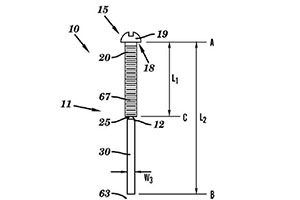We wrote recently about a summary judgment decision in which Judge Indira Talwani found certain asserted claims of two patents on a type of breakable screw to be obvious in light of the prior art. This ruling came even though the patentee had produced some evidence of copying, and even though the accused infringer had not shown a motivation to combine. The case provides useful insights into the law on patent obviousness, and this post expands on the obviousness issues in more detail.

In a lengthy opinion addressing a number of different issues, Judge Talwani first ruled that several other claims in each of the patents were anticipated by the prior art, which included two examples of previously-available breakable screws. The specific claims at issue here, however, were deemed not anticipated because they added additional elements, such as describing particular lengths for a non-threaded screw portion.
The fact that the claims survived an anticipation challenge, however, did not mean that they would survive an obviousness challenge based on the same prior art references. Eyeego contended that the patent claims were not obvious in light of the prior art in part because Hilco had not shown any evidence of a motivation to combine or modify any prior art references. Relying on the Supreme Court’s precedent in KSR v. Teleflex, Judge Talwani pointed out that evidence of such a motivation is not required to prove obviousness; because the claims are nothing more than "predictable variations" on the prior art, they are obvious.
Although Eyeego had presented some objective evidence of non-obviousness, in Judge Talwani's view, this still could not save the patents, even at summary judgment. Eyeego had presented some evidence of copying – the inventor had presented her patented screw to Hilco, which had had the opportunity to review and evaluate the invention before coming out with its allegedly infringing product. Eyeego contended that at the summary judgment stage, this showing was sufficient to overcome the obviousness challenge. But to Judge Talwani, this "scant" evidence of copying was insufficient. Citing a recent Federal Circuit decision in the ongoing Apple v. Samsung litigation, Judge Talwani found that Eyeego's copying evidence was simply not enough to overcome an obviousness finding, where as was the case here, there is a “substantial question of validity” raised by the prior art.
In the changing landscape of obviousness law, this case is a good example of how the obviousness jurisprudence can play out. Even at summary judgment, and where there are only two prior art references and no motivation to combine, patentees may find that they need more than scant objective evidence in the record to overcome an obviousness motion.
The case is The Hilsinger Company v. Eyeego, LLC, Civil Action No. 1:13-cv-10594-IT (D. Mass.), before Judge Indira Talwani. A copy of the opinion can be found here.
Accused Infringer Puts the Screws on Patentee
The content of this article is intended to provide a general guide to the subject matter. Specialist advice should be sought about your specific circumstances.

